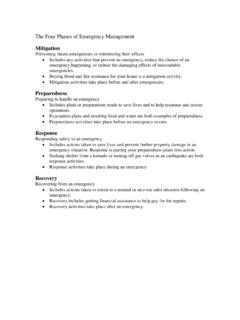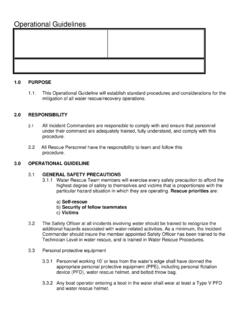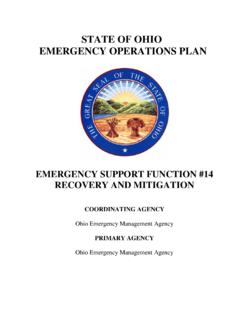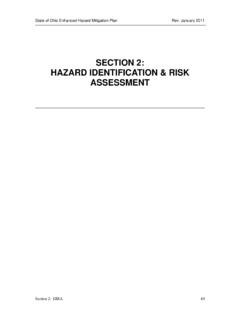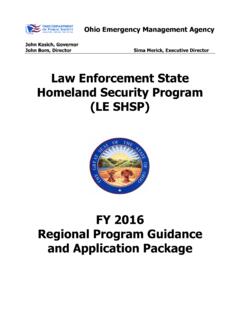Transcription of Sample Debris Management Plan Annex
1 * Sample Debris Management PlanDeveloped by the Ohio emergency Management Agency and theOhio Environmental Protection AgencyOctober 2002* To be incorporated into the planning format adopted by the of 1 Concept of 1 Normal 2 Increased 4 6 Roles and 10 Supplemental 14 AttachmentsAttachment 1: Debris Management Fact SheetAttachment 2: Sample Driving Route to TDSR Attachment 3: List of Solid Waste Facilities Attachment 4:List of Qualified ContractorsAttachment 5: Sample Documentation ( ) Example Mutual Aid Agreement ( )Example Right of Entry Agreement ( )Example Time and Materials Contract ( ) Example Lump Sum Contract ( ) Example Unit Price Contract ( )Attachment 6:Demolition Checklist Attachment 7:Navigational Hazards Checklist Attachment 8: Debris Reduction MethodsAttachment 9:TDSR Closeout ChecklistAttachment 10:TDSR Closeout Issues1 Sample plan for Debris ManagementPurpose This document will define roles, responsibilities, and procedures and provide guidance fordevelopment and implementation of all elements involved in managing Debris procedures/guidance for decision-makers to manage Debris removal of OperationsThe concept of operations describes how Debris Management activities will be conducted inresponse to Debris generating events as a phased approach.
2 The phased approach is a four-stepcycle that includes normal operations, increased readiness, response, and recovery. All communities have unique circumstances that impact their responses to disaster events, basedon local business/industry, land use, size of the community, topography, economics, etc. Thecounty must address those unique circumstances during the development of the plan . This focusis necessary to address the extraordinary demands placed on public/private resources for debrismanagement following a disaster event. Debris Management CycleNormalOperationsResponseDebrisManag ement CycleIncreasedReadinessRecovery Planning Issues Disposal Issues Staffing Issues Removal Issues2 Normal operationsPrior to an emergency /disaster the county, townships, cities, and villages will designate a debrismanagement coordinator (DMC).
3 The DMC will be responsible for reviewing and updating theplan as needed. This plan will include the following sections:1. List of Contacts and Job Descriptions: To include current information on name,addresses, phone numbers (office, home, pager, and cell) fax and email. 2. List of Qualified Contractors: Eligible to conduct business with government entities toinclude type of work each contractor can perform with availability of equipment, type ofcollection, removal, and reduction of Debris . 3. Types of Contracts: The following types of contracts may be used when conductingdebris Management operations. Time and Material: Under a time and material contract, the contractor is paid on thebasis of time spent and resources utilized in accomplishing Debris Management Federal emergency Management Agency recommends, for reimbursementpurposes, that the use of time and material contracts be limited to the first 70 workhours following a disaster event.
4 Unit Price: A unit price contract is based on weight (tons) or volume (cubic yards) ofdebris hauled, and should be used when the scope of work is not well defined. Itrequires close monitoring of collection, transportation, and disposal to ensure thatquantities are accurate. A unit price contract may be complicated by the need tosegregate Debris for disposal. Lump Sum: A lump sum contract establishes a total price using a one item bid from acontractor. It should be used only when a scope of work is clearly defined, with areasof work and quantities of material clearly identified. Lump sum contracts can bedefined in one of two ways: Area Method, where the scope of work is based on a one time clearance of aspecified area, or Pass Method, where the scope of work is based on a certain number of passesthrough a specified area, such as a given distance along a right of Sample Contracts: Include contracts as attachments to the plan .
5 Attachment 6 to thisdocument includes samples of these contract Right-of-Entry/Hold Harmless Agreements: Disaster response activities will requireentering private property to remove Debris that is a threat to the health and safety ofoccupants. The county, townships, cities and villages will evaluate and select location on3government owned property. The following issues will be addressed prior to Debris Removal: Establish a process for Debris removal from public and privateproperties. Priorities for removal will be determined during the response Temporary Debris Storage and Reduction (TDSR) Site: The county, townships, cities andvillages will evaluate and select locations that may be used as TDSR sites. Preferenceshould be given to public property rather than private. The following issues will beaddressed during normal operations for a TDSR site.
6 Location: Care should be taken in selection of TDSR sites. Land use, proximity tohousing, and other factors that may impact the use of the site should be taken intoaccount. Operations: Monitoring receipt of Debris and verifying types of Debris received arecritical functions for successful operation of a TDSR site. Included in theattachments to this document is a Sample TDSR site layout. Closeout: In order to close out a TDSR site, care should be taken to restore the site toits original condition in an environmentally friendly and timely manner. Included inthe attachments to this document is a checklist for site Environmental Compliance: Following a disaster event, compliance with environmentalprotection laws and regulations is still required. Federal and State EnvironmentalProtection Agencies and local Health Departments should be consulted for applicableregulatory Documentation: Documentation of Debris Management activities is important forpotential reimbursement of costs.
7 In addition, documentation is important to recordactivities performed and authorizations granted, and to develop a historical record forupdating plans. Documentation of activities is the responsibility of those performingwork as well as those who provide oversight and direction. At a minimum,documentation needs to address the following: Labor, equipment, rental fees and material costs. Mutual-aid agreement expenses. Use of volunteered resources, including labor. Administrative expenses. Disposal costs. Types of Debris collected and amounts of each ReadinessIn some instances there is a warning that a disaster may occur. This section covers actions takenin the event of a potential Debris -generating event. Actions for consideration include:Alerting Personnel: Procedures for alerting personnel are available in the County EmergencyOperations plan (EOP).
8 Reviewing and Updating the plan : Ensure personnel understand roles and responsibilities forplan implementation. Review existing contracts, list of qualified contractors, Sample contracts,right of entry/hold-harmless agreements, and other contracts necessary to conduct debrismanagement Waste Management Options: Ensure pre-selected temporary Debris storage andreduction sites are currently available for use. Identify alternative locations if necessary. Ensureauthorized waste transfer or disposal facilities are currently operational. Identify alternativefacilities if those used during normal operations have been impacted by the to a disaster is a very important step for setting the tone on how the recovery will section covers the response phase of a Debris -generating event. Actions necessary in theshort-term response phase include:Activation of the plan : The Debris Management staff will be a component of the EmergencyOperations Center (EOC) and will coordinate and manage Debris removal operations.
9 Establishment of Debris Removal Priorities: When a Debris -generating event occurs there is animmediate need for prioritization of actions. Debris will include fallen trees, limbs, trash,furniture, food waste, scrap tires, utility poles and wires, vehicles, building materials, hazardousmaterials, infectious materials, animal carcasses, silt and mud, etc. Develop and implement apriority system for Debris removal. The first priority shall include roadways that allow ingressand egress to the critical public facilities such as fire stations, police stations, hospitals, and othercritical facilities. Other essential, but perhaps not critical facilities include schools, municipalbuildings, water treatment plants, wastewater treatment plants, power generation units, airports,temporary shelters for disaster victims, etc. The county will need to prioritize Debris removalfrom roadways that allow ingress or egress to these facilities.
10 Activation of standby contracts: Standby contracts are contracts with companies that make thecompany available for assistance in the event of a Debris -generating event. The standbycontracts are in place before a disaster occurs. Develop a list of standby contracts that arereached between the community or county and contractors. Tracking of Resources: Procedures for tracking resources are available in the County EOP. Thelevel of detail in the tracking system will be dependent upon the size and magnitude of and Briefings: Procedures for holding meetings and providing briefings are available inthe County EOC. The main purpose of the meetings is to brief EOC staff on current and futuredebris Management activities. Debris Management staff should participate in all EOC meetingsand provide briefings as necessary. Review of Documentation Process: Evaluate when and why decisions were made to performcertain actions.
